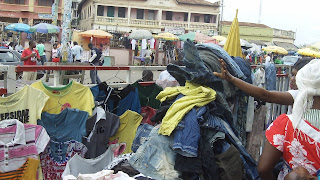It has now been two months that I have lived in Ghana. This pseudo-sorority house that I live in has begun to feel quite homey. In some respects, anyway. To get inside you must pass through a gate protected by barbed wire and security officers. All of the houses here have such safety measures. The guard smiles as I walk by, and greets me using my name. Our guards had learned all twenty-one residents’ names before I had learned the six of theirs! We exchange pleasantries and I swipe my key to enter the house. Immediately inside is a foyer, then the living room. A gush of refreshingly cold air hits me and I walk inside. To the right, the kitchen, two large rooms joined together with three refrigerators, ovens, sinks, and six-burner stovetops. There are eight coffee pots, four microwaves, two blenders, and a seemingly infinite number of utensils, pans, and dishes. And yet about half the time, I cannot for the life of me find a clean fork.
Behind the kitchens is the laundry room with six industrial-strength washers and dryers. The rest of the house consists of bedrooms. There are a few downstairs, mine among them. Upstairs is where most of the girls live, and the two boys of the house. Those poor boys, you may think? You’re right. It is quite easy to write off a house full of nineteen girls and two boys as all female. The boys find themselves accidentally present for the most graphic discussions about yeast infections and dreamy movie stars. We swoon as we watch Moulin Rouge and gossip endlessly on our long bus rides around the country.
Most recently, we traveled to Kumasi, the second-largest city in Ghana (Accra is the largest). The group left at 4:30 AM and traveled 156 miles to our destination, arriving at 11 AM. Due to traffic, our three-hour bus ride had turned into seven. This is not uncommon in Ghana. We rushed to our tour of the Manhyia Palace, where the Asantiye (King of the Ashanti tribe) lives. Cameras were not allowed inside the palace. We saw the original Talking Drums that were used to communicate between the past Asantiye and members of the tribe. The inside of the palace was filled with belongings of past Kings, as well as shockingly lifelike statues of deceased Kings and Queen Mothers.
 |
| Peacocks guard the entrance to the Manhyia Palace. |
When a King dies, the Queen Mother chooses the next Asantiye. Kingship is passed down through the men in her family. She must decide which of her male sons or nephews is worthy of the position, and advise him during his reign. She is a senior member of the tribe; a requirement for the position is to be post-menopausal. This is common Ghana, since a menstruating woman is often considered bad luck. Women are typically not allowed to touch certain sacred artifacts, or approach men of great spiritual importance. In some regions, women are forced to leave their house during their periods for fear of sullying their husbands. Post-menopausal women, however, are excused from any of these prejudices and are essentially treated like men.
After seeing Manhyia Palace, we drove to the Center for National Culture and participated in a Batik-making class. Batik is a type of traditional fabric that is hand-dyed and printed.
 |
| At the Batik class, we chose pre-dyed fabrics and stamps with traditional Adinkra prints. |
 |
| First, wax is melted over a fire. |
 |
| The stamps are dipped into the hot wax... |
 |
| and pressed onto the cloth. |
 |
| The cloth is soaked in dye, dried in the sun, and ironed. |
 |
| The final product |
The next day, we went to the Kumasi market. This was absolutely the most exciting part of the trip. The Kumasi market is the largest open market in West Africa. Infinite fields of stalls, stands, and vendors splayed out before us, full of food, fabric, clothing, toiletries and shoes and everything else you could possibly want. For three hours we explored the endless stalls, bargaining with vendors and warding off aggressive locals. Fifty cedis, the equivalent to about $35, bought me an aggregate 15 yards of fabric, three pairs of shoes, a scarf, popping corn, and a comb.
 |
| Kumasi market, the largest market in West Africa |
 |
| Looking down a row of stalls |
 |
| Shirts for sale at the Kumasi market |
 |
| A road splitting the market |
It was a short trip. After the market we were back on the bus for a seven-hour drive. On long, uncomfortable rides like that, you go through stages. First, everybody falls asleep. After the first rest stop we are awake, chatting, snacking, gossiping. The noise gradually subsides as we fall asleep again. After the second rest stop we are awake again. Then we grow angsty, resentful of this damn bus and the people on it. An hour later we are singing, whipping our hair to Willow Smith. Poor boys.
When we get home there is no water, but the air conditioning works. Victory.


No comments:
Post a Comment